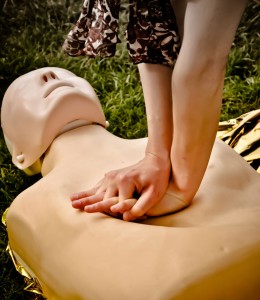Safety First Aid Training regularly gets asked about the correct procedure for administering chest compressions when performing cardiopulmonary resuscitation (CPR). There has been recent discussions within the industry about 1/3 adult chest compressions. Safety First Aid Training believes that the Resuscitation Council (UK) guidelines are the most up-to-date and relevant procedures and we deliver training in line with this and according to HSE requirements.
As a First Aider the most life threatening condition you may be faced with is dealing with a casualty who is not breathing. Firstly, you will need to conduct a primary survey and this can be easily remembered by (DRABC) Danger, Response, Airway, Breathing and Circulation.
Once you have established basic life support is required, the emergency services have been informed and you have commenced cardiopulmonary resuscitation (CPR), it is important to ensure the correct depth compressions to the chest are made.
- For adults compress the chest to a maximum depth of 5-6cm, 30 times at a rate of 100-120 compressions per minute.
- For children compress the chest 4-5cm, 30 times at a rate of 100-120 compressions per minute.
- Following 30 compressions, open the airway and deliver 2 effective rescue breaths.
CPR has been known to cause injury to a casualty’s ribs, liver, lungs and heart. However, these risks must be accepted if CPR is necessary to save the casualty’s life. As stated in an earlier article about ‘First Aider Insurance’, the casualty would not be ‘worse off’ from the injuries, so it would be difficult to prove negligence and be held liable even if you are out of work and not covered by your workplace insurance policy.
Ensure your CPR skills are refreshed and become competent in administering First Aid. Click here to view our selection of approved First Aid courses. We can provide training materials, manuals, risk assessments and first aid equipment, please ask us for details.

